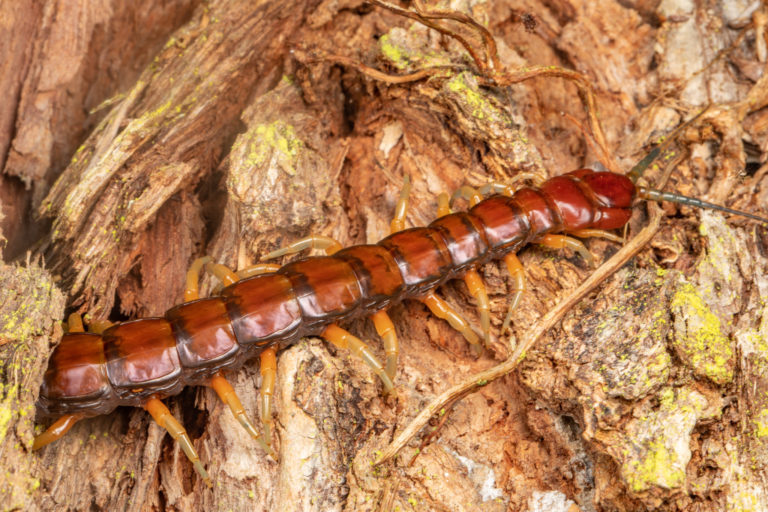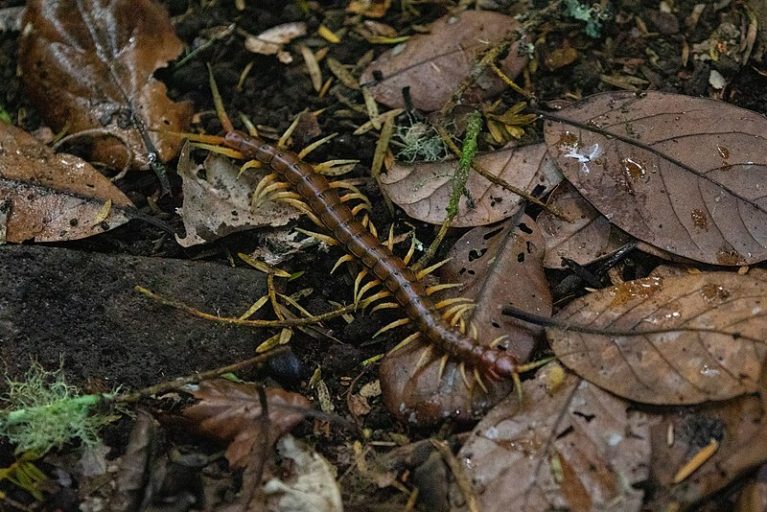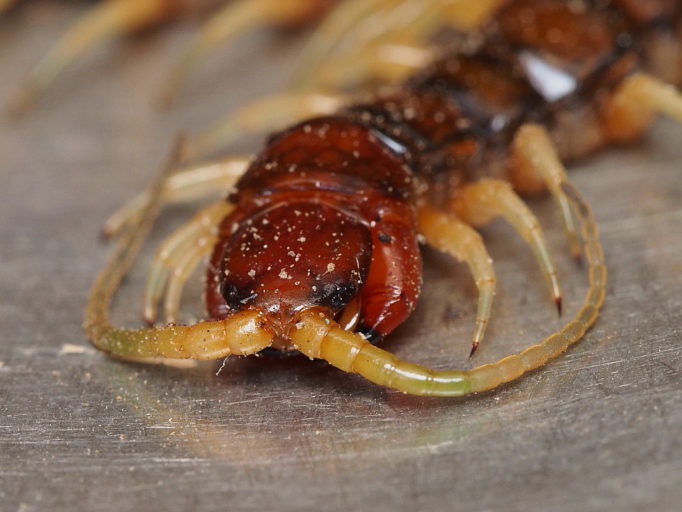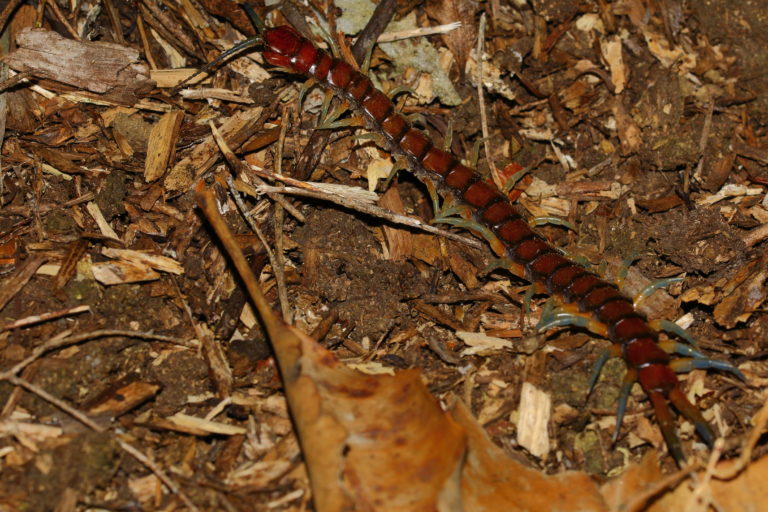‘Giantism’ is a bit of a thing on isolated islands – Aotearoa/New Zealand once had its giant eagle and giant moa – and we still have a few giants out there lurking in the undergrowth. One of those is our giant centipede (Cormocephalus rubriceps). Some sources say it gets to 16cm in length. Other sources say 25cm! Maybe we just haven’t found a fully grown one yet.

If you do come across one, beware! Its bite isn’t actually poisonous to humans – so it probably won’t do any lasting harm – but it really hurts!
Giant centipedes are only found in the North Island and nearby islands, so southerners can relax, walk barefoot, sit on that forest log if you want to. But northerners tread carefully… Actually if you leave it alone, it will probably leave you alone, but if you’re curious, centipedes are fascinating creatures.
Known as hara or hura to Māori, the giant centipede is most often seen in the north of the North Island. It’s also found in Australia (so its native to New Zealand, but not endemic – not unique to Aotearoa). It shelters under or in logs and amongst leaves on the ground and it’s carnivorous, crushing and piercing prey with its fearsome jaws, or mandibles.

The centipede’s poison claws are an impressive and unique feature of centipedes. These large, robust, pincer-like appendages – known as forcipules – are located on the first segment following the head and are actually modified legs, which function as jaws. They are jointed, open and close in horizontal plane and end in sharp claws.
Centipedes use their forcipules to capture and poison their prey. The ducts of poison glands open near the tips of the claws. The forcipules are found in all centipedes but don’t occur in any other arthropods.
Our giant centipede belongs to the Scolopendridae family of centipedes, known for its many-legged giants. There’s an Amazonian cousin of our giant centipede that gets even bigger. Scolopendra gigantea, the Amazonian giant centipede, is the largest existing species of centipede in the world, reaching over 30 cm (12 in) in length. It eats lizards, frogs, birds, spiders, mice, and even bats, catching them in mid-flight.
One thing to note about centipedes is that, in spite of their name, there is no species of centipede that actually has exactly 100 legs. Oddly, in most cases, females have more legs than males. The number of leg-bearing segments varies from 15 to 191, but the developmental mode of their creation means they are always added in pairs—hence the total number of pairs is always odd.
Worldwide, 8,000 different species of centipedes are thought to exist, of which 3,000 have been described. So there may be even bigger centipedes out there somewhere! Centipede fauna of New Zealand is distinctly southern (Gondwanan) in type and includes at least 35 species. Several genera are endemic – found only in Aotearoa.
Centipedes have a wide geographical range, even reaching beyond the Arctic Circle. They are found in a variety of habitats from tropical rainforests to deserts but all habitats have one key requirement – they must have a moist microhabitat. Centipedes lack the waxy cuticle of insects and spiders. That means they rapidly lose water, so centipedes are found in soil and leaf litter, under stones and dead wood, and inside logs.
Centipedes are among the largest terrestrial invertebrate predators, but they are often blind. Many species of centipedes lack eyes completely, but some have a variable number of ocelli, which are sometimes clustered together to form true compound eyes. However, these eyes are only capable of discerning light and dark and have no true vision.

In some species, the first pair of legs at the head end of the centipede acts as sense organs similar to antennae, but unlike the antennae of most other animals, the centipede’s point backwards. Other unusual sense organs found in some groups are the organs of Tömösváry. These are located at the base of the antennae and consist of a disc-like structure with a central pore surrounded by sensory cells. They are probably used for sensing vibrations and may even provide a sense of hearing.
Have you ever wondered how is it that centipedes never trip over their many legs? Believe it or not, their legs are all different lengths.
Behind the head, the body consists of 15 or more segments. Most of the segments bear a single pair of legs, with the maxillipeds projecting forward from the first body segment, and the final two segments being small and legless. Each pair of legs is slightly longer than the pair immediately in front of it, ensuring that they don’t overlap, reducing the chance that they will collide with each other while moving swiftly. In extreme cases, the last pair of legs may be twice the length of the first pair.
Centipedes are relatively long-lived when compared to insects. One widely distributed species, Scolopendra subspinipes can live for over 10 years and some European species live for 5-6 years.
The centipedes are classified into five orders – Geophilomorpha, Scolopendromorpha, Lithobiomorpha, Scutigeromorpha and Craterostigmomorpha. New Zealand’s giant centipede, Cormocephalus rubriceps, belongs to the Scolopendromorpha order. Most of New Zealand’s Scolopendromorpha, especially the soil dwellers, are much smaller and don’t get any bigger than 5 cm. One thing common to all Scolopendromorpha is that they always have twenty-one pair of legs.
Although they are predators themselves, many centipedes are preyed upon by birds and mammals. In New Zealand, introduced rats have reduced the numbers of the giant centipede Cormocephalus rubriceps. Due to rat predation, full-sized individuals are now found only on rat-free islands, as the mainland centipedes fall victim to predators before they reach the maximum size. Predatory ground beetles and large spiders may also hunt centipedes, particularly the juveniles.
Female giant centipedes are caring mothers. The female lays an egg mass in a cavity excavated in the soil. She remains in the cavity coiled around the eggs until they have hatched. The newborn centipedes resemble miniature adults and have the adult number of legs, although the reproductive parts are not developed. Growth and development is through a series of moults.
Each stage of development lasts for several months, and in cold climates a centipede can take 2-3 years to reach maturity. Adult centipedes continue to moult, further increasing in size. Many die after their first breeding season, but many continue to live and moult for several more years.
Centipedes are able to regenerate lost appendages – the regenerating appendage slowly develops with each consequent moult, although a perfect appendage is regenerated only if the injury had occurred at an early stage in development; otherwise the regenerated appendage is deformed and stunted.

Not all New Zealand’s centipedes belong to the Scolopendromorpha order. The centipede Craterostigmus is a unique creature with a very restricted distribution and has been placed in a separate order Craterostigmomorpha. Craterostigmus tasmanianus from Tasmania and the recently described Craterostigmus crabilli from New Zealand are the only species in the order.
The New Zealand Craterostigmus is a medium-sized (up to 5 cm), greenish-brown centipede, with a large, elongate, red-brown head. The forcipules are massive and clearly visible from above, framing the head. The adult Craterostigmus have 15 pairs of legs but 21 tergites, as some tergites are subdivided. There is one pair of ocelli (light sensors).
Craterostigmus occurs in forest habitats of the South Island, where it is quite common, but little is known about the biology of this centipede in New Zealand. So who knows what fascinating centipede weirdness is yet to be discovered…

